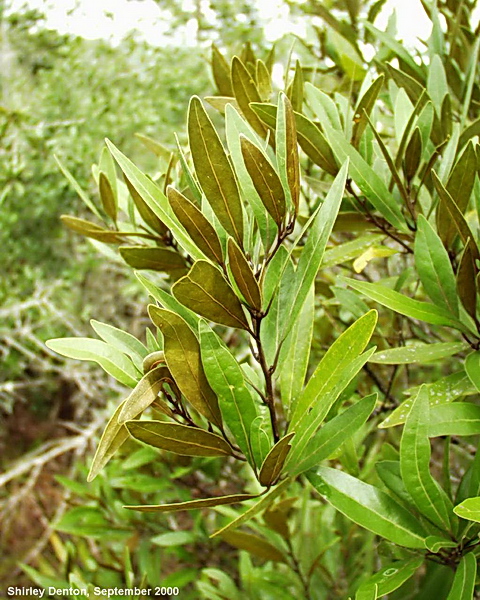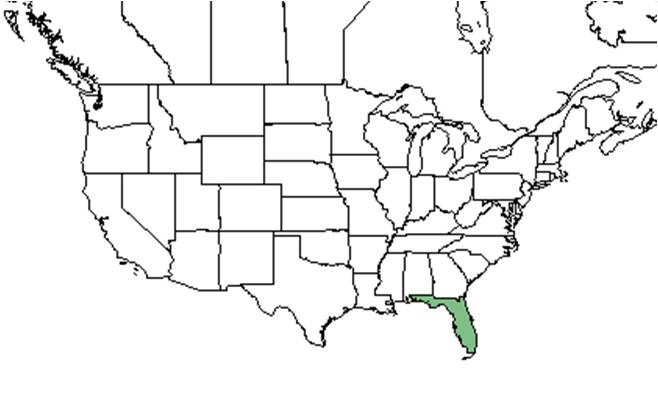Persea humilis
| Persea humilis | |
|---|---|

| |
| Photo by Shirley Denton (Copyrighted, use by photographer’s permission only), Nature Photography by Shirley Denton | |
| Scientific classification | |
| Kingdom: | Plantae |
| Division: | Magnoliophyta - Flowering plants |
| Class: | Magnoliopsida – Dicotyledons |
| Order: | Laurales |
| Family: | Lauraceae |
| Genus: | Persea |
| Species: | P. humilis |
| Binomial name | |
| Persea humilis Nash | |

| |
| Natural range of Persea humilis from USDA NRCS Plants Database. | |
Common name: Silk bay; Scrub bay[1].
Contents
Taxonomic notes
Synonyms: Tamala humilis (Nash) Small; Persea borbonia var. humilis (Nash) L.E. Kopp.[1]
Varieties: none.[1]
Description
A description of Persea humilis is provided in The Flora of North America. It is a tree/shrub with shiny, green leaves. The lower leaf surface has dense, appressed hairs with a rusty or blackish color, depending on the age. They are uniform across the surface of the veins. These hairs on the lower side of the leaf help reduce water loss. The peduncles are 1-3 cm long and the leaf blades are 5-8 cm long.[1]
Distribution
P. humilis is limited to the scrubs of the Florida peninsula.
Ecology
Habitat
P. humilis has been found in sandhills, sand pine stands, sand pine scrub, coastal thicket, oak-pine-palmetto scrub, rosemary scrub, Turkey-oak and scrub pine woods, and Xerophytic oak scrub.[2][3][4][5] It is also found in disturbed areas including along roadsides and powerline clearings.[6] Associated species: Quercus laevis, Quercus geminata, Vitis munsoniana, Quercus inopina, Helianthemum nashii and Pinus palustris.[3][7]
Pollination
Persea humilis has been observed at the Archbold Biological Station to host plasterer bees from the Colletidae family such as Colletes brimleyi and C. nudus, sweat bees from the Halictidae family such as Augochlorella aurata and Augochloropsis metallica, thread-waisted wasps from the Sphecidae family such as Bicyrtes quadrifasciata and Cerceris fumipennis, and wasps from the Vespidae family such as Euodynerus apopkensis, Polistes metricus and Pseudodynerus quadrisectus.[8]
Conservation, cultivation, and restoration
Cultural use
Photo Gallery
References and notes
- ↑ 1.0 1.1 1.2 1.3 Weakley, A.S. 2015. Flora of the southern and mid-atlantic states. Working Draft of 21 May 2015. University of North Carolina at Chapel Hill, Chapel Hill, North Carolina.
- ↑ Florida State University Herbarium Database. URL: http://herbarium.bio.fsu.edu. Last accessed: May 2021. Collectors: R. Kral, Walter S. Judd, and Robert F. Thorne. States and counties: Florida: Highlands, Marion, and Ocala.
- ↑ 3.0 3.1 Botanical Research Institute of Texas, Philecology Herbarium accessed using Southeastern Regional Network of Expertise and Collections (SERNEC) data portal. URL: http://sernecportal.org/portal/collections/index.php Last accessed: May 2021. Collectors: C. L. Lundell and Julie Perreau. States and Counties: Florida: Levy. Texas: Aransas.
- ↑ Carnegie Museum of Natural History Herbarium accessed using Southeastern Regional Network of Expertise and Collections (SERNEC) data portal. URL: http://sernecportal.org/portal/collections/index.php Last accessed: May 2021. Collectors: Thompson, S.A. States and Counties: Florida: Marion.
- ↑ Eastern Kentucky University, Ronald L. Jones Herbarium accessed using Southeastern Regional Network of Expertise and Collections (SERNEC) data portal. URL: http://sernecportal.org/portal/collections/index.php Last accessed: May 2021. Collectors: B. Eugene Wofford. States and Counties: Florida: Ocala.
- ↑ Archbold Biological Station herbarium accessed using Southeastern Regional Network of Expertise and Collections (SERNEC) data portal. URL: http://sernecportal.org/portal/collections/index.php Last accessed: May 2021. Collectors: A. Arcuri, Vander Kloet, D. Richardson, and R.P. Wunderlin. States and Counties: Florida: Highlands, Marion, and Ocala.
- ↑ Clemson University Herbarium accessed using Southeastern Regional Network of Expertise and Collections (SERNEC) data portal. URL: http://sernecportal.org/portal/collections/index.php Last accessed: May 2021. Collectors: Patrick D. McMillan. States and Counties: Florida: Polk.
- ↑ Deyrup, M.A. and N.D. 2015. Database of observations of Hymenoptera visitations to flowers of plants on Archbold Biological Station, Florida, USA.